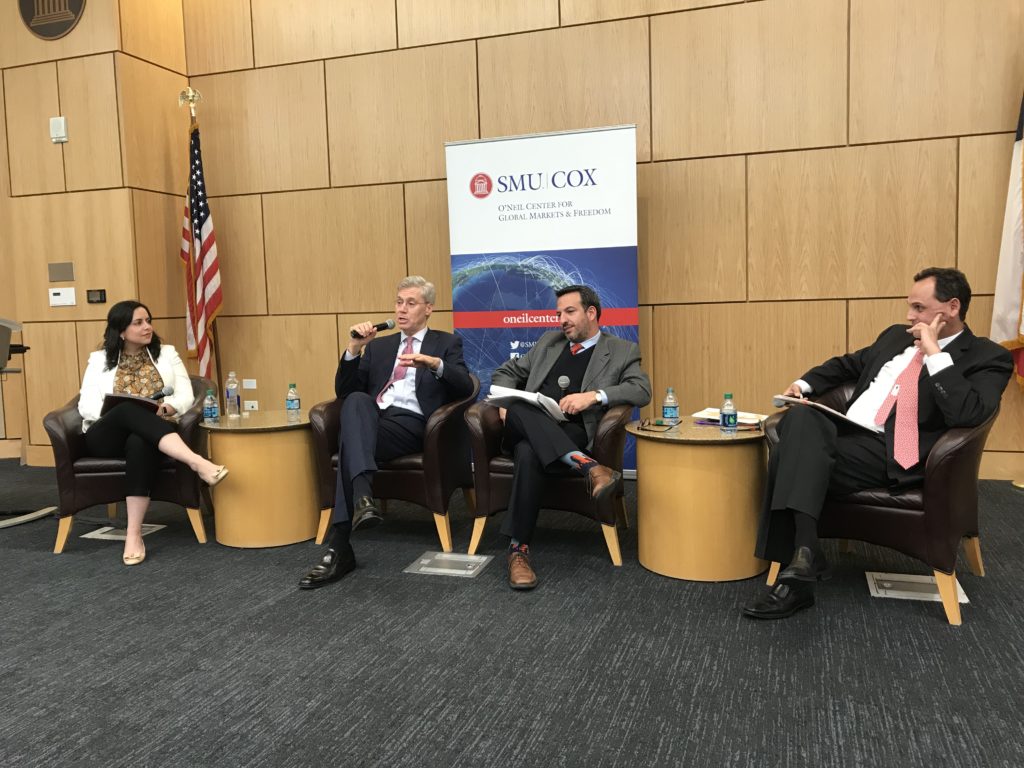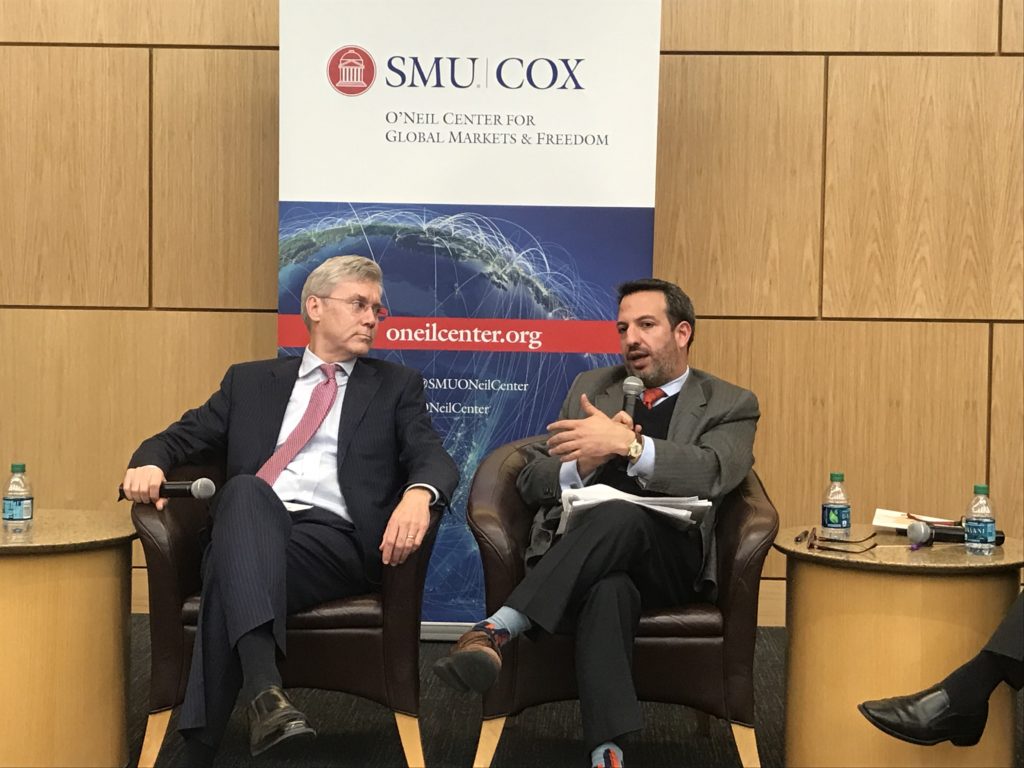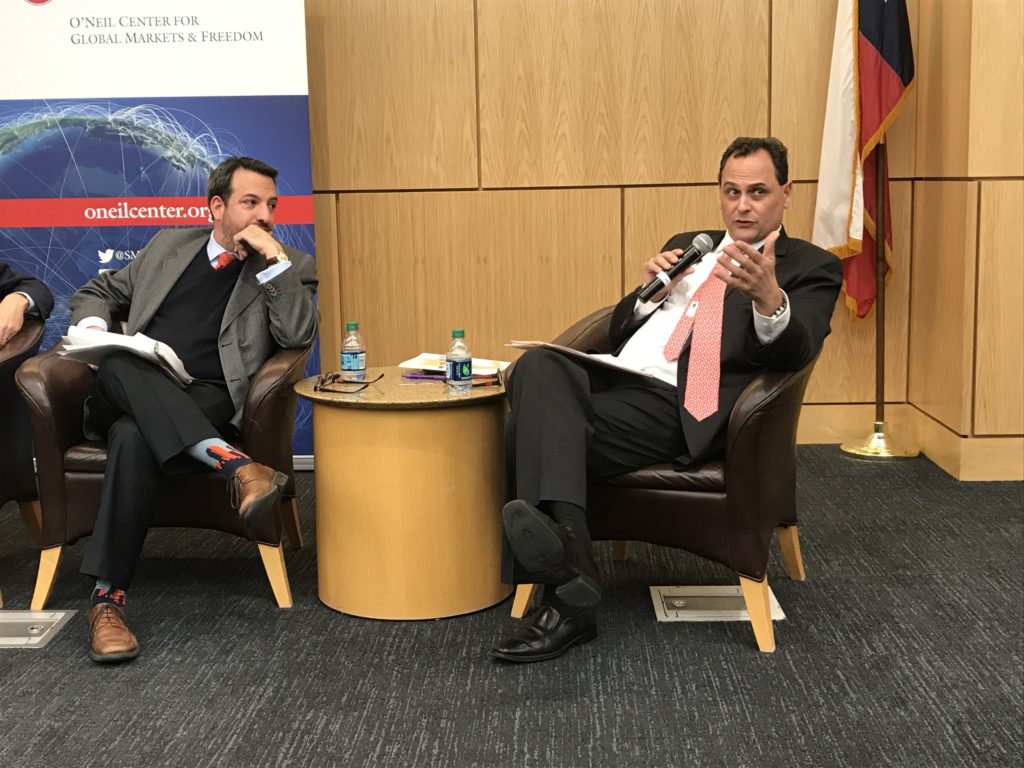Call it USMCA, NAFTA Redux, NAFTA 2.0, or “The Trade Agreement formerly known as NAFTA.” If you’re Canadian, you can call it CMUSA or Mexican call it T-MEC (Tratado entre México, Estados Unidos y Canadá).
You can even call it by its name: The United States-Mexico-Canada Agreement.
But until it’s actually approved by Congress or scuttled by the Trump Administration or parsed into enough consequential side-letters to obviate its free trade intentions, the complex trade relationship that has developed between the North American nations over the past 25 years remains at an uncomfortable crossroads.
A change in administrations in Mexico, the volatility along the U.S.-Mexico border and a general preference within the Trump Administration for bilateral relationships are creating uncertainties about the new trade framework even before it is approved, said Timothy Leahy, chief legal officer for Latin America for AT&T, at a gathering last week at the Edwin L. Cox Business School on the campus of Southern Methodist University.

“There are a lot of dynamics that make for an uncertain future,” Leahy said.
Leahy was one of three trade experts asked to assess the status of the new trade agreement and how it might affect businesses that have come to depend on the trading environment that has developed since NAFTA came into effect in 1994. The program – “The New NAFTA: Getting Down to Business” was hosted by the SMU Cox O’Neil Center for Global Markets and Freedom, The Texas Lawbook and SMU’s Mission Foods Texas-Mexico Center.
Panelist Andres Alvarez, foreign legal consultant at Foley Gardere, said some of the most sweeping changes are likely to be felt in the auto industry, where new requirements for parts origination and dramatic raise in salary standards are likely to have a dramatic effect, whether for better or worse.

“Probably one of the hardest fights in the negotiations was the automotive industry, “ said Alvarez, who noted that negotiators looked at the origin of each component and increased the local labor and regional content of all the various parts.
To qualify for zero tariffs, for instance, cars must have 75 percent of their components manufactured in North America. By 2023, 40 to 45 percent of auto parts have to be made by workers making at least $16 per hour. Moreover, Mexico has the obligation to pass laws to provide protections for labor organizing as well as base-line protections for migrant workers.
“I think that probably cars will get more expensive,” said Alvarez. “Whether that’s good or not, the bottom line will be a matter of cost/benefit analysis.”
Alberto de la Peña, co-chair of the international practice group at Haynes and Boone, said the auto provisions seem to be designed, in his view, to repatriate American jobs, but that their political effect in Mexico has yet to be seen.
“It is the auto industry that suffers most under the agreement,” said de la Peña.
Both Alvarez and de la Peña described the union movement and labor laws in Mexico as a mixed bag with “good” unions with strong member involvement and “bad” unions that are primarily disruptors with corrupt intent. Since the latter cannot legally target companies that are already organized, some have formed unions within the companies that are little more than placeholders, lending the company immunity from “bad union” disruptions.
“There are companies that had unions that they didn’t know existed,” said de la Peña.
Of particular concern to some, and no concern to others, is the complicated structure of the new agreement, as opposed to NAFTA. Where NAFTA was a treaty of 19 discreet chapters, the USMCA is spread over 34 chapters, 13 agreement annexes and 14 side letters of particularized bilateral agreements on everything from research and development expenses and distilled spirits to water resources and cheese.
Panel moderator Luisa del Rosal, executive director of the SMU Dedman College Mission Food Texas-Mexico Center, asked whether the profusion of side-letters might undermine the free trade elements of the original agreement.
From de la Peña’s view, the structure reflects the political urgency behind agreement. During the 2016 presidential campaign, President Trump had promised to abrogate NAFTA, and under the subsequent time pressures to renegotiate provisions of NAFTA, the result took on a variety of sub-agreements in the form of “side-letters,” particularly in industries – like dairy and automobiles – with on-going international disputes.

“Such agreements are pretty normal in the world of mergers and acquisitions,” de la Peña said.
Key to any agreement is enforcement and dispute resolution, and under the new agreement enforcement is streamlined and specific – for certain industries. Leahy said the most beneficial changes are the result of changes in the Mexican constitution rather than the agreement itself. While some industries – particularly those regarding natural resources – retain traditional layers of national protection, others – like the telecom industry are, in AT&T’s experience, regulated with both efficiency and fairness.
“In Mexico, our chief competitor is TELMEX. It is a great organization owned by the Mexican industrialist Carlos Slim. He is tremendously influential in Mexico. And under those circumstances, as a foreign-owned company you need some comfort that you will be treated well,” Leahy said.
Leahy said newly-constituted provisions of Mexican law allow private action, if disputes cannot be settled with regulators. “The mere existence of those provisions will help us get a fair hearing for our dispute,” Leahy said. “We (AT&T) have been treated very fairly by regulators in Mexico.”
But Leahy said telecom is very different from involvement in oil and gas and other natural resources. Where telecom is some ways has the high-tech effect of being invisible, resources are historical and visceral.
“Natural resources are personal. Wireless is invisible. There is a lot of history there that makes a difference,” Leahy said.
From the point of view of all three panelists, the future of the new agreement is not assured, particularly in the U.S. Ongoing tariffs and the threat of new tariffs are a constant concern. So is the possibility that the Trump Administration will simply dump the agreement as part of some other initiative – or to simply make a point.
But while it must negotiate a divided Congress, the USMCA contains unique elements that should be pleasing to all parties including: the increased influence of labor, the protection of regional markets and the conservation of 25 years of continental cooperation under NAFTA.
Likewise, Mexico’s new president, Andrés Manuel López Obrador, though largely inimical to the Trump Administration – and particularly its border policies – has the luxury of waiting quietly while the U.S. processes the agreement.
